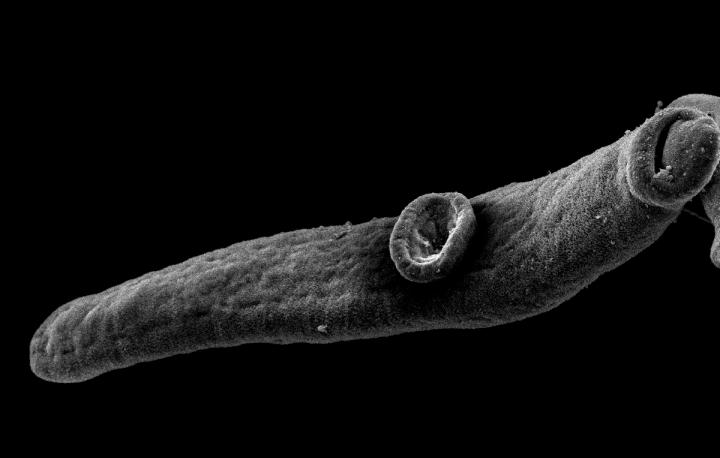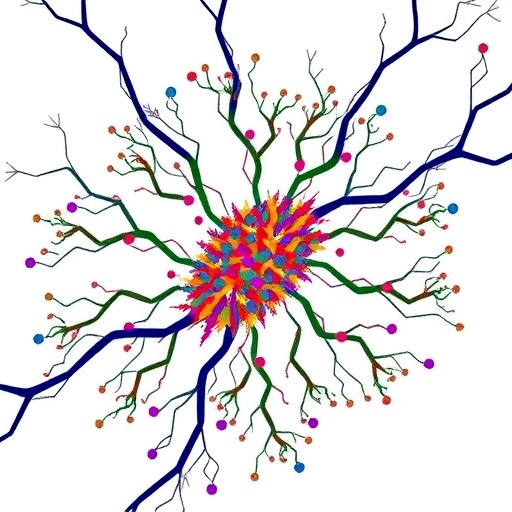Blood flukes and Helicobacter pylori: co-infection changes immune response

Credit: Clarissa Prazeres da Costa / TUM
A team at the Technical University of Munich (TUM) has completed the first study of the effects of a simultaneous infection with blood flukes (schistosomes) and the bacterium Helicobacter pylori – a fairly common occurrence in some parts of the world. They identified a complex interaction which resulted – among other effects – in a weakening of the adverse impact of the pathogens acting individually.
Around 240 million people worldwide are afflicted with schistosomiasis, an illness caused by flatworms of the genus schistosoma, commonly known as blood flukes. These parasites generally enter the human body with water from lakes, ponds or rivers. Worms, larvae and eggs are transported to various organs in the body through the bloodstream. The species Schistosoma mansoni is especially damaging to the liver, where it causes cirrhosis.
Helicobacter pylori is a bacterium that colonizes the human stomach. One in three people in Germany carry it and the worldwide rate is actually around 50%. Infections are associated with stomach ulcers and cancer. In places where schistosomes are widespread, as in some African countries south of the Sahara, co-infections with Helicobacter pylori are frequent. A team headed by Prof. Clarissa Prazeres da Costa and Prof. Markus Gerhard of the Institute for Medical Microbiology, Immunology and Hygiene at TUM used mice to study what happens in a co-infection with Helicobacter pylori and Schistosoma mansoni.
Misdirection of T-cells and reduction of liver cirrhosis
In a schistosomiasis infection, the initial infection is followed by an acute phase, superseded about five weeks later by a chronic phase. In their study, Prazeres da Costa and Gerhard show that fewer T-cells are found in the stomach during the acute phase of schistosomiasis. In hosts infected only by Helicobacter pylori, these immune cells are more numerous in the stomach and cause inflammation there. “We show that the schistosomiasis drives an increase in chemokine levels in the liver. The chemokines attract the T-cells and, in a sense, misdirect them to the liver,” says Markus Gerhard. This leads to a reduction in stomach inflammation, he explains.
This effect fades away when the chronic phase begins, however. While hosts infected with schistosomiasis alone often suffer liver damage during that phase, this is less common with co-infections. In their investigations, Prazeres da Costa and Gerhard detected elevated quantities of the signalling protein IL-13dRa2 in the blood of mice infected with the bacteria. “IL-13dRa2 can provide protection against cirrhosis and can even reverse tissue changes,” says Clarissa Prazeres da Costa. “We therefore believe that they could play a decisive role to reduce the extent of liver cirrhosis in co-infections.”
Possible effects on vaccines
In everyday life, many people are repeatedly re-infected with schistosomes because they come into frequent contact with water containing the worms. „As a result, there is no time limit on the diversion of T-cells to the liver because the chronic and acute phases occur simultaneously,” explains Clarissa Prazeres da Costa.
At first glance, the interactions in case of a co-infection may look like a positive side effect: Although the infected individual is suffering from two illnesses, the harmful effects of both are seemingly reduced. “Co-infections can have other consequences, however. For example, the changed immune response can limit the effectiveness of vaccines,” says Markus Gerhard. “Co-infections are widespread especially in poorer regions,” adds Clarissa Prazeres da Costa. “We urgently need more studies on their effects and ways of dealing with them, for example in order to develop new and more effective vaccination strategies.”
###
Publication:
Bhattacharjee S, Mejías-Luque R, Loffredo-Verde E, Toska A, Flossdorf M, Gerhard M, Prazeres da Costa C.”Concomitant Infection of S. mansoni and H. pylori Promotes Promiscuity of Antigen-Experienced Cells and Primes the Liver for a Lower Fibrotic Response”. Cell Rep. 2019 Jul 2;28(1):231-244.e5. DOI: 10.1016/j.celrep.2019.05.108
More information:
Prof. Prazeres da Costa is the co-director of the Center for Global Health (CGH) at the Technical University of Munich. The CGH is concerned with the promotion of health and the prevention of ill-health at a global level. It brings together and initiates research projects and teaching activities that address global health issues across different disciplines. Website: https:/
Prof. Gerhard is the co-director of the TUM research presence PYLOTUM at Peking University, a reference laboratory operated jointly with the Peking University School of Oncology for the study of cancers of the upper gastrointestinal tract. The research presence conducts research projects in basic science and clinical studies in particular on helicobacter pylori and cancers of the stomach. Website: http://pylotum.
High-resolution images:
https:/
Contact:
Prof. Dr. Clarissa Prazeres da Costa
Technical University of Munich (TUM)
Institute for Medical Microbiology, Immunology and Hygiene
Tel.: +49 (0) 89 4140 4130
[email protected]
Prof. Dr. Markus Gerhard
Technical University of Munich (TUM)
Institute for Medical Microbiology, Immunology and Hygiene
Tel.: +49 (0)89 4140 – 2477
[email protected]
Media Contact
Paul Hellmich
[email protected]
Original Source
https:/
Related Journal Article
http://dx.




